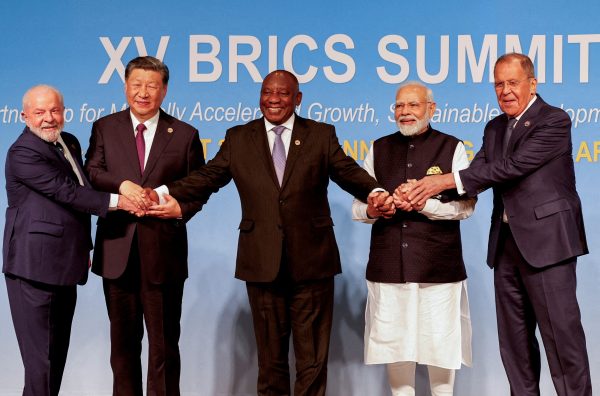At the BRICS Summit in Johannesburg on 24 August 2023, the bloc’s five members — Brazil, Russia, India, China and South Africa — announced the invitation of six new countries — Argentina, Egypt, Ethiopia, Iran, Saudi Arabia and the United Arab Emirates. Effective 1 January 2024, BRICS countries will represent almost half the world’s population.
While BRICS has struggled to make concrete achievements, the momentum may now be shifting. This expansion would have the BRICS overtake the G7 in total gross domestic product, with BRICS economies growing at higher demographic and economic rates than G7 members.
The BRICS expansion could help reduce tensions among the BRICS’s Middle Eastern countries, but could also provoke the United States and NATO, given the admission of Iran and the current membership of Russia and China.
A growing number of countries have expressed interest in joining the BRICS group. Yet there are internal disagreements about how the group should move forward. China and Russia have pushed a quick expansion of BRICS to strengthen their geopolitical influence, while India has expressed concern about admitting many new members too quickly.
India’s concern has much to do with its historic, bitter border disputes with China, as well as the current strength of India’s bilateral relationship with the United States. India’s contribution in keeping BRICS from becoming outwardly anti-Western only strengthens the country’s geopolitical importance for the United States — US President Joe Biden quite literally pulled out the red carpet for India’s Prime Minister Narendra Modi during his June 2023 visit to the White House.
Many countries view BRICS as an alternative to groups like the G7 or G20, which condition membership on specific values and foreign policy commitments. India, for instance, is at risk of backlash from the international trading system due to its renewed ethnonationalist policies.
Through the expansion of BRICS, China will increase its footing in the developing world, helping spread its model of ‘non-interventionism’. This model aligns with members such as Brazil and Ethiopia, who have indicated their disinterest in the China–US economic and US–Russia geopolitical quarrels, preferring to take advantage of other economic opportunities offered by BRICS.
Plans for expanded membership are in the works, with 20 countries applying for membership. Participation is not restricted on any political or ideological basis. Nigeria, Angola, Mozambique and the Democratic Republic of Congo, all with very concerning human rights records but regional geopolitical weight, have been floated for membership.
Leaders in the developing world are already noticing the divide in approaches between the BRICS and the G7, with some noting that the BRICS presents an opportunity for states wanting to decouple from the West.
Still, there are important caveats to the BRICS expansion. The group has been pushing to decouple from dollarisation in favour of alternative currencies, such as the Chinese yuan and the Brazilian real. Some countries, like Brazil and Argentina, have taken great steps to de-dollarise, while others have been slower.
There also appears to be little unity between the bloc’s great power leaders and its smaller members. Brazil, India and South Africa have all been aiming for membership on the United Nations Security Council, with little material support from China and Russia, both permanent members. Unlike the G7, there is also little in common culturally, economically and geopolitically with many BRICS members, beyond their wish to reshape the global order.
Yet the BRICS has been coherent, slowly but meticulously eating away at the West’s influence over the global order. BRICS members have been taking over previously liberal-led global institutions and creating new institutions with support from China, Russia and at times India.
BRICS countries are offering a path of engagement for states not wanting to conform to liberal values and norms while still seeking to reap the economic benefits of a global order. New members will also enjoy greater access to Chinese project financing through the BRICS bank and other Chinese-led financial institutions.
Another caveat relates to China’s non-interventionist posturing and value projection. China-aligned states are willing to accept Beijing’s messaging and disregard its expansionist policies in Taiwan, Hong Kong, Tibet, Xinjiang, the South China Sea and Africa in exchange for diplomatic and economic benefits. Still, China’s posturing seems to be resonating with certain segments of the world previously harmed by Western imperialist campaigns, including parts of the Middle East, Africa, Southeast Asia and Latin America.
The G7 is often grouped with these campaigns due to the West’s failure to reshape its global image, its own foreign military campaigns and its ties to Western military blocs including NATO. So while China’s posture may be greatly flawed, some areas of the world are wanting an alternative. In some countries, economic and diplomatic closeness with China is more popular domestically than closeness with the West, as Chinese financing and trade programs tie in material benefits to engagement.
Given that G7 countries have continued to champion ‘values’ and the preservation of the ‘liberal order’ as key tenets, the G7 may be contributing to the increasing influence of BRICS. If the United States and G7 push litmus tests too directly, developing nations may simply join the other blocs. Internal geopolitical developments and a strong counterreaction may be the only ways to halt BRICS’s advancement.
Joseph Bouchard is a freelance journalist covering geopolitics and conflict and a Masters of International Affairs candidate at Carleton University, Ottawa.
Sophie Egar is a Visiting Researcher at Iracambi Rainforest Research and Conservation and a Masters candidate at Johns Hopkins School of Advanced International Studies.

